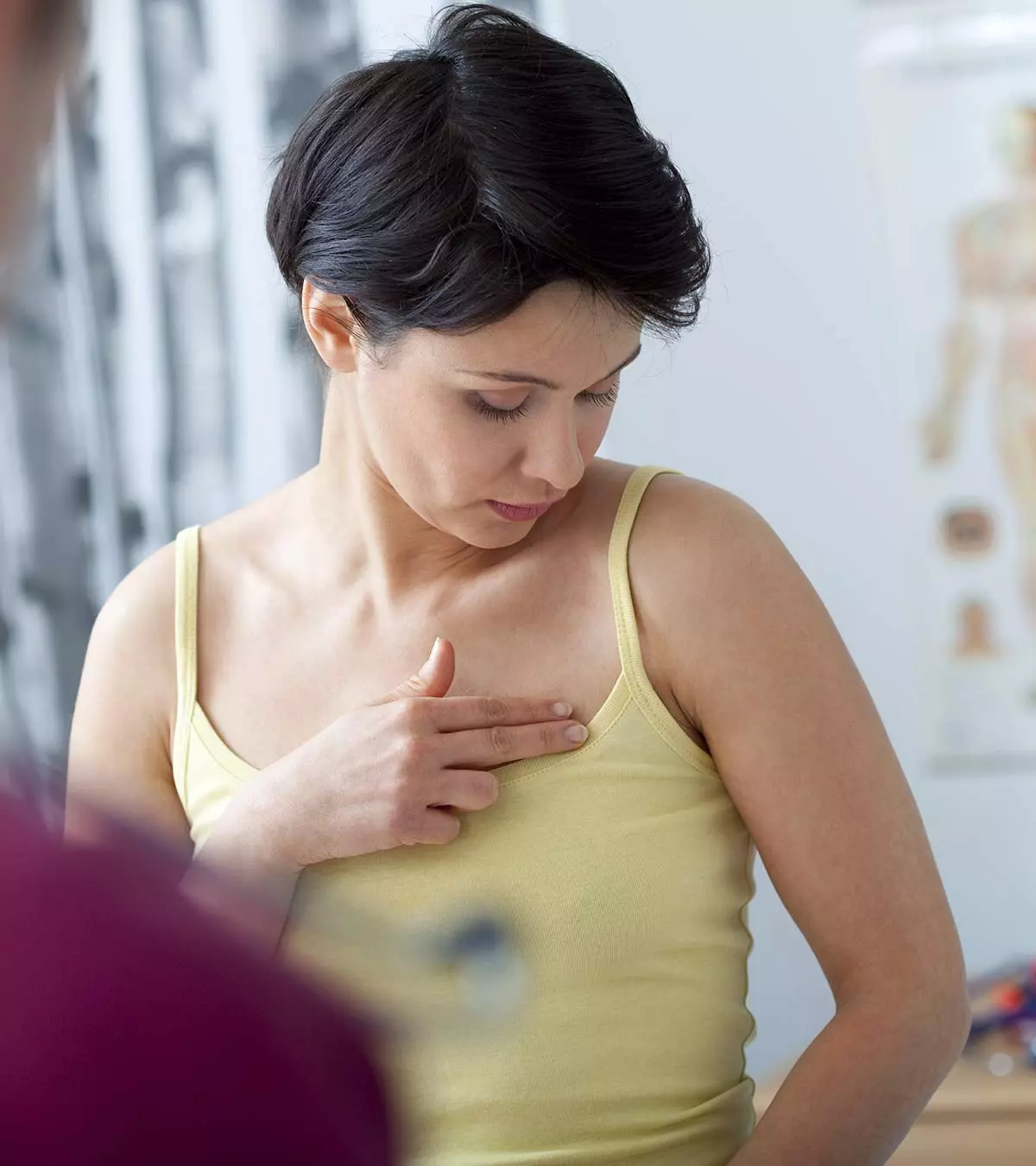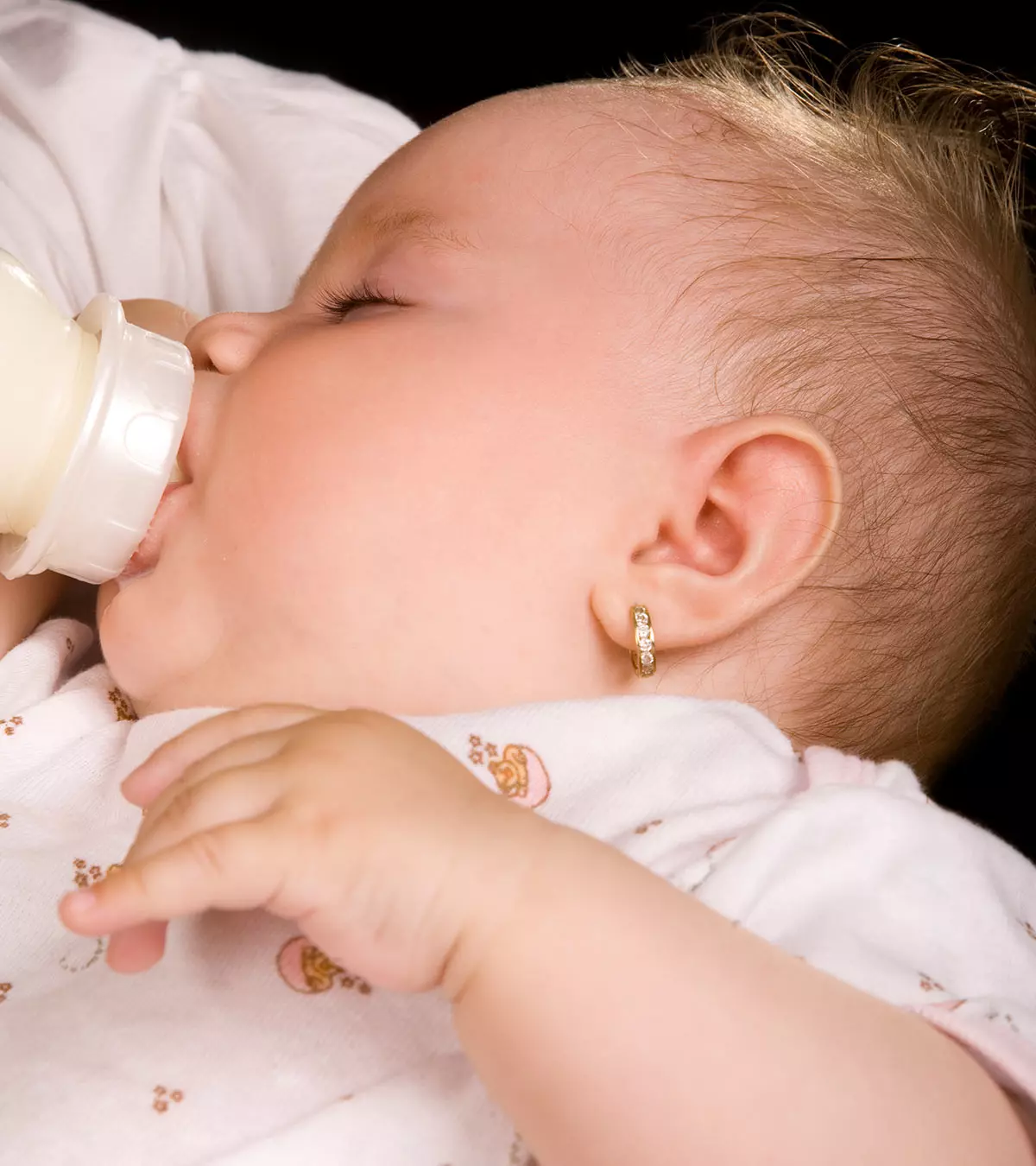
Image: ShutterStock
Looking at your saggy breasts after pregnancy/breastfeeding might make you think, ‘do breasts shrink after pregnancy? You should know that breast sagging is a natural aspect of post-pregnancy adjustments. It’s also known as ‘ptosis,’ and it’s more of a cosmetic change than a medical concern.
This post discusses the causes of drooping or sagging breasts following pregnancy and strategies to prevent this change.
Key Pointers
- Stretched Cooper ligaments and enlarged breasts during pregnancy cause breast sagging.
- Breast sagging can also result from multiple pregnancies, larger breasts, weight loss, higher body mass index, aging, and smoking.
- Prevent breast sagging by wearing a supportive bra, managing weight gradually, moisturizing breasts, quitting smoking, and taking hot and cold showers/massages.
- Maintaining healthy skin and connective tissues in breasts is possible with good breastfeeding posture, exercise, and a healthy diet.
- Push-ups, Arm raises, Bench press, and Chest fly can prevent breast sagging.
What Causes Breast Sagging After Pregnancy Or Breastfeeding?
The breasts are attached to the muscles by Cooper ligaments, which hold them in position (1). These ligaments are subjected to tension as early as the first trimester; they get heavier and fuller over the course of the pregnancy. As time passes, the elasticity of the stretched Cooper ligaments may be weakened, leading to sagging. It is not breastfeeding alone that causes the breasts to sag, but rather pregnancy, genetics, and other factors.
During pregnancy, the breasts undergo changes as they prepare for breastfeeding. The milk glands grow and, therefore, there is an increase in breast size, which may be one of the causes for the sagging of breasts.
During the postpartum period , the breasts increase in size. Breast milk continuously fills the breasts, causing the skin to stretch. You may also notice engorgementiPainful swelling of the breasts caused due to excessive milk production during breastfeeding. and inflammation, which are likely to alter the breast shape.
Once you wean, the milk-producing glands return to their original size. It is believed that this process could leave the breasts empty, shrinking the fatty breast tissue and, therefore, making them look saggy and flabby.
Breast sagging could increase with subsequent pregnancies, but breastfeeding may not have an impact on the unshapely appearance of the breast (2).
Other factors that are likely to cause breast sagging include:
- Multiple pregnancies
- Larger breasts
- History of weight loss
- Higher body mass index (BMI)
- Aging and smoking—both contribute to a reduction in skin elasticity (3)
 Health fact
Health factCan Breastfeeding Lead To Sagging Of The Breasts?
Contrary to popular belief, breastfeeding does not directly lead to sagging of the breasts. The primary causes of breast sagging are the size changes that occur during pregnancy. As a woman’s body prepares for breastfeeding, her breasts naturally increase in size and become fuller (4).
After breastfeeding, some women may notice changes in the shape and size of their breasts, but these alterations are mainly due to the natural effects of pregnancy rather than breastfeeding itself (5).
It’s important to note that factors such as aging, gravity, insufficient breast support, smoking, sun exposure, and fluctuations in weight can also contribute to breast sagging over time.
How To Prevent Breast Sagging After Pregnancy/Breastfeeding?
Listed below are some ways that may help in preventing breast sagging or firming up the breasts.
1. Wear a supportive bra
Wear a correct-fitting and supportive bra. Choose one that is non-elastic and has wide straps. It should be snug and fit the entire breast tissue into the bra cup. The nipple line should remain between the elbow and the shoulder, whereas the back of the bra should stay between the shoulder blades. Also, do not choose a bra with plastic or metal underwires (6).
 Point to consider
Point to consider2. Manage your weight
Gaining weight during pregnancy is essential but you can try not to gain too much weight. The excess weight you gain during pregnancy might add more fat tissue to your breasts (7).
3. Moisturize your breasts
Follow a postpartum skin care routine. All the rapid stretching during pregnancy could leave the skin dry. Apply a mild and safe moisturizer on your breasts as it maintains hydration and prevents your breasts from becoming unfirm, or looking untoned. Exfoliation using a gentle body scrub or loofah could also help, just make sure to avoid the areola and nipple area. Having moisturized skin restores elasticity better than dry skin.
4. Lose weight gradually
Once you have had your baby and are planning to lose weight, talk to your doctor first. You may want to lose all the weight at once, or as fast as you can. Try to lose weight slowly and steadily. This may give your skin the time it needs to adapt to the changes.
5. Stop smoking
Smoking may accelerate the skin’s aging process (8). It could, therefore, cause the breast and skin tissue to lose firmness.
6. Maintain a good breastfeeding posture
A leaning forward posture while breastfeeding (considered a poor posture) may have a negative effect on your breasts. For a good posture, use a nursing pillow or any other support that could raise the baby to your breast level. Try to keep your shoulders, back, and spine supported and in a straight position. Many mothers find the laid back, also called the natural position, very comfortable. Here, a mother is in a semi-reclined position, and the baby is on her stomach laying on top of her. This position ensures that the mother’s back is completely relaxed and gravity works for her.
7. Take a hot and cold shower/massage
Hot water improves blood circulation, whereas cold water is said to improve skin tone. While taking a shower, alternate between the hot and cold water, and massage your breasts. Finish the shower with cold water. Breast massage, called therapeutic breast massage, if done prior to or between feedings, improves circulation in the breasts as well as prevents milk statisiAccumulation of excessive breast milk due to incomplete emptying of the breasts or blockage in the milk ducts. .
8. Follow a healthy diet
Pay attention to your post-pregnancy diet. Include foods rich in complex carbohydrates, protein, and healthy fats as they provide the body with necessary nutrition. It could help keep the skin and connective tissues of the breasts healthy. Eat foods rich in vitamin E (leafy greens, nuts, and seeds) and vitamin B (eggs, poultry, and fish) as they improve skin tone.
9. Wean your baby gradually
When you plan to wean your baby, do it over time. Reduce the number of feeding sessions gradually. This could help regain the pre-pregnancy form of the breasts, as well as let your body adjust the hormones slowly.
10. Exercise regularly
Incorporating a well-designed exercise routine during and after pregnancy might help in preventing saggy breasts. You may start with simple and low-level strength exercises in your pregnancy. Target your pectoral and back muscles as it could help your breasts appear tighter and lifted. Once you get clearance from your doctor, postnatal exercise routines can be introduced after about six weeks. Strengthening and toning exercises could make a difference in preventing sagging or pendulous breasts. Consider wearing a supportive sports bra while exercising.
Exercises To Prevent Breast Sagging
Given below are some chest exercises that might help tone the muscles and prevent breast sagging.
1. Push-ups

Image: Shutterstock
They may help firm up the breasts and the chest muscles (9).
How to do:
- Lie down on your tummy, preferably on a yoga mat.
- Place your palms on the floor.
- Raise your body using the arms (there should be a slight bend at the elbow to avoid any injury).
- Lower yourself to the floor as far as you can, and again push back.
- Repeat it until you find it comfortable.
2. Arm raises

Image: Shutterstock
This targets the upper body, especially the shoulders and arms.
How to do:
- You may do this exercise while sitting with your legs folded, standing, or sitting on an armless chair.
- Extend your arms over the head as much as possible, keeping your elbows slightly bent.
- Remain in this position for some time, and slowly lower your arms.
- Repeat and do it often during the day.
3. Bench press

Image: Shutterstock
This is a strength-building exercise for the pectoral muscles (chest), shoulders, and back. Take on the help of a fitness expert in a gym as you would need a pair of dumbells and a bench.
How to do:
- Lie flat on a bench and hold a dumbbell in either of your hands.
- Raise your hands slowly and hold them above your chest.
- Remain in the position for a while.
- Slowly bring down the arms close to the chest.
- Repeat a few times.
4. Chest fly

Image: IStock
It works on the chest, arm, and back muscles, thereby toning them.
How to do:
- You will need a chest fly (pec deck) machine to do this exercise.
- Sit straight with both your feet flat on the floor and grab the handles.
- Press your arms towards the chest slowly, and keep the elbows bent.
- Remain in this position for a second.
- Get back to the original position, opening your chest.
- Repeat for a few times.
These exercises may not necessarily help bring back the shape of your breasts, but they might help tone them up. Talk to a professional before taking up any of these exercises and make sure to stay hydrated.
Breast Involution After Pregnancy And Breastfeeding
The return of an organ to its original size is called involution. Breast involution might happen about three months after your baby starts weaningiThe process of transforming your baby’s diet from breastmilk to solids and other liquids. or stops breastfeeding. Not all women may experience the same degree of involution. In certain instances, the breasts may appear deflated as the breast tissue becomes shrunken while leaving the surrounding skin unaltered (10).
Sagging Breasts And Plastic Surgery
Several surgical options could help in lifting and reshaping the droopy breasts. Breast augmentationiA surgical procedure where implants are placed inside the breasts to enhance their size and appearance. and breast lift surgery are two well-known procedures that certified plastic surgeons perform (11). If you are in the childbearing stage or trying for subsequent pregnancies, breast surgery may not be an option to consider. Moreover, it is expensive. Consider the benefits and risks carefully, and consult a certified dermatologist to determine if surgery is suitable for your condition.
Does Wearing A Bra At Night Prevent Sagging?
There is no scientific backing to this belief. If you do choose to wear a bra at night, make sure it’s soft, comfortable, and fits you well. You should not wear an underwire bra or one that’s tight and puts pressure on your breasts. Tight bras and underwires can cause plugged milk ducts or mastitisiInfection in the breast tissues usually caused by bacteria or blocked milk ducts leading to pain and inflammation while breastfeeding. . If you leak at night, and need to use nursing pads, a soft nursing tank top might be a good solution.
Breasts undergo several changes during pregnancy to prepare for breastfeeding, and during the nursing period, the skin of the breast stretches as the breasts get filled with milk. Once you wean, the fatty breast tissue shrinks in size and may lead to unappealing breasts. It is not unusual for women to experience sagging breasts after breastfeeding. Wearing a supportive bra, maintaining a healthy weight, moisturizing your breasts, maintaining a proper breastfeeding posture, and doing strength exercises can prevent sagging. You may also consider a cosmetic correction if you are too conscious about saggy breasts after pregnancy or breastfeeding.
Infographic: Tips To Prevent Sagging Breasts After Pregnancy Or Breastfeeding
Pregnancy and breastfeeding give way to numerous physical changes, including breast changes in a woman. Although these changes depend on various factors, you may consider following the suggestions detailed in this infographic to prevent sagging breasts after pregnancy and breastfeeding. Keep scrolling! Illustration: Momjunction Design Team
Frequently Asked Questions
1. How do I lift saggy breasts naturally?
It is tough to fix sagging breasts without surgical intervention. However, exercises that improve the tone of the muscles behind the breasts may help improve the overall appearance of the breasts (12).
2. How do I know if my breasts are saggy?
If your breasts seem flattened, slackened, deflated, or resembling pancakes, it may indicate sagging. A stretched-out or loose appearance of breasts may indicate sagging (13).
Illustration: Ways To Prevent Sagging Breasts After Pregnancy & Beyond

Image: Dall·E/MomJunction Design Team
References
1. Allyson B. Rivard, Laura Galarza-Paez, and Diana C. Peterson.; Anatomy, Thorax, Breast; StatPearls Publishing (2020).
2. Rinker B, Veneracion M, and Walsh CP.; The effect of breastfeeding on breast aesthetics; Aesthet Surg J. (2008).
3. Rinker B,Veneracion M, and Walsh CP.; Breast ptosis: causes and cure; Ann Plast Surg. (2010).
4. The Six Common Causes Of Breast Sagging; Piedmont Healthcare
6. Physical Changes and Concerns; Weeks 13-21 of Pregnancy; State of South Dakota Publishings
7. Joe Giessler; What is normal weight gain during pregnancy; The Ohio State University Wexner Medical Center (2018).
8. Wrinkles, Aging, And Skin Protection; Women’s Health Research Institute; Northwestern University
9. How and Why Your Breasts Might Change; RRDS Clinical Guide. Physical Fitness: A Guide for Individuals with Lower Limb Loss; Office of Research & Development – VA
10. Ronald D. Beesley and Julia V. Johnson; The Breast During Pregnancy and Lactation; The Global Library of Women s Medicine (2008).
11. Rod Rohrich; Breast augmentation vs breast lift – picking the right procedure for you; American Society of Plastic Surgeons (2017).
12. What causes saggy breasts?; The Cadogan Clinic
13. Better breasts after pregnancy and breastfeeding; American Society of Plastic Surgeons
14. Normal changes in your breasts; The Royal Women’s Hospital
15. Katherine Wood, et al.; Breast size, bra fit and thoracic pain in young women: a correlational study; National Library of Medicine (2008)
Community Experiences
Join the conversation and become a part of our nurturing community! Share your stories, experiences, and insights to connect with fellow parents.
Read full bio of Rebecca Koyf
Read full bio of Rebecca Malachi
Read full bio of Swati Patwal
Read full bio of Dr. Joyani Das
















